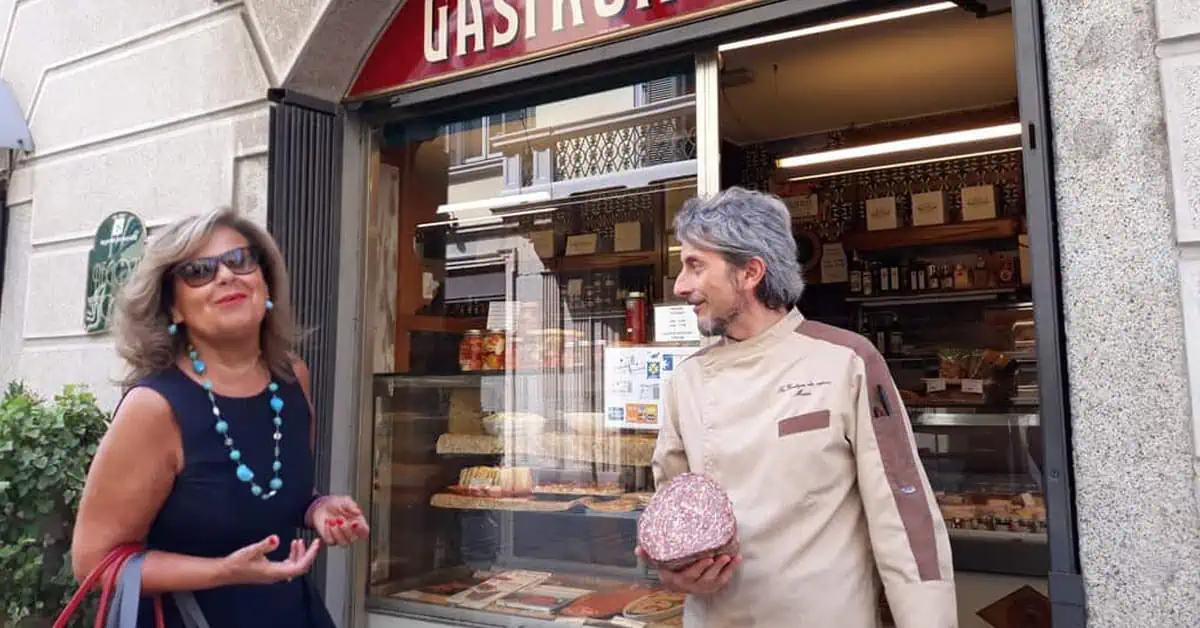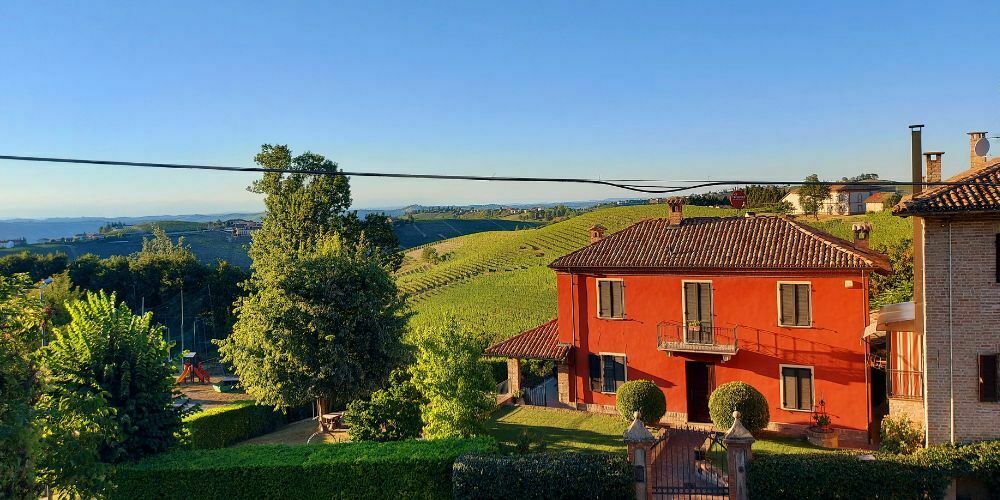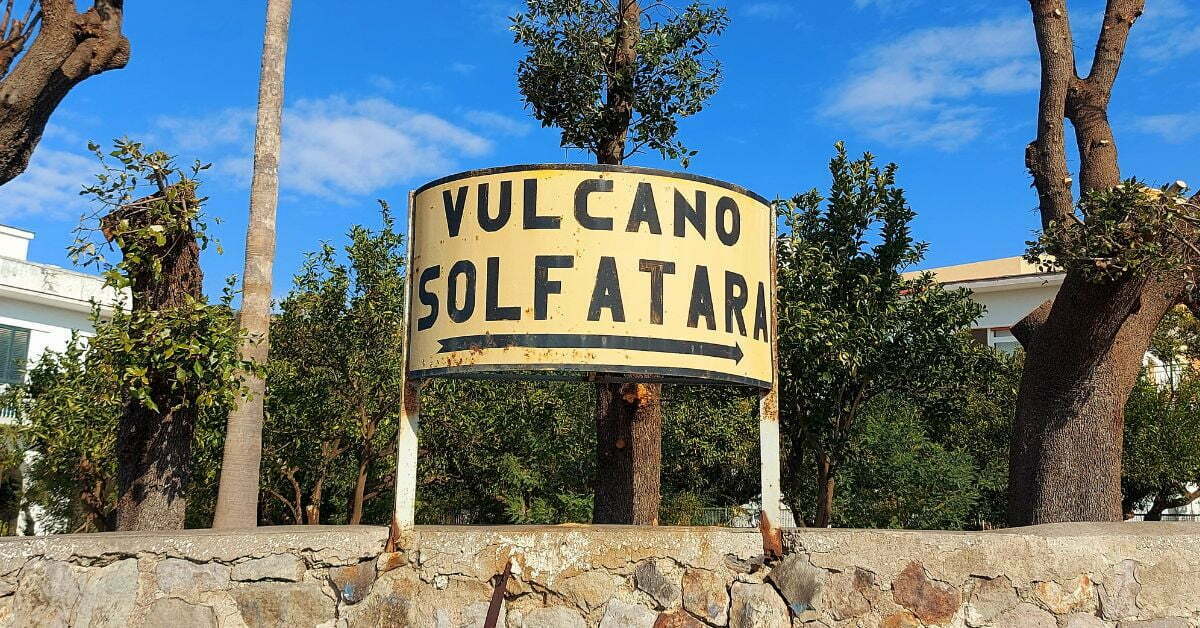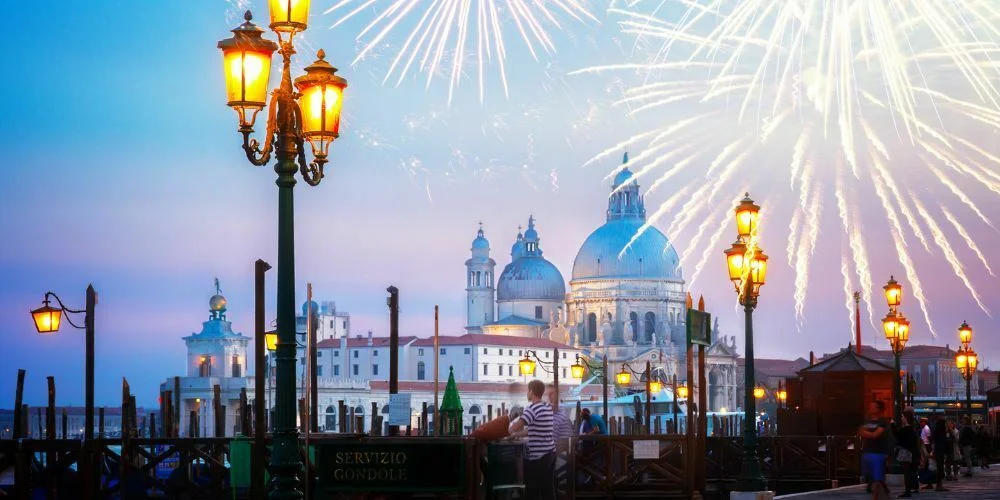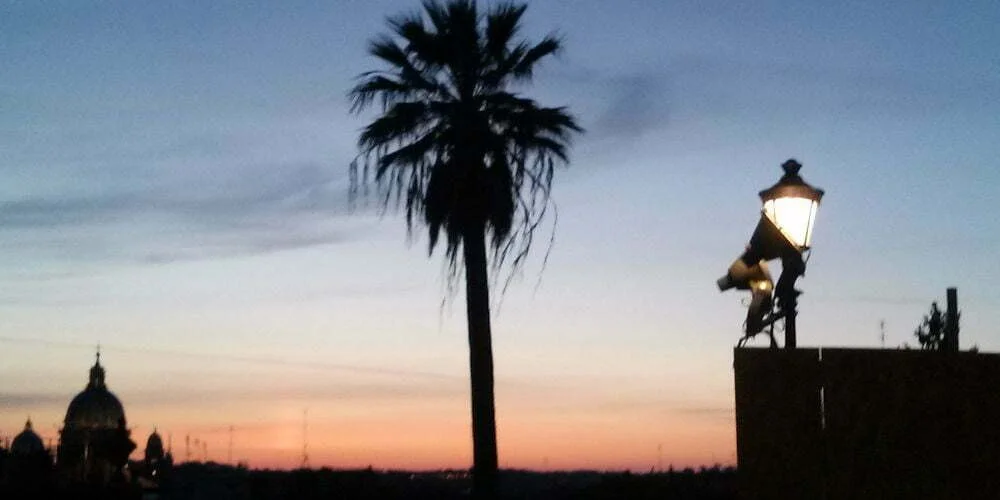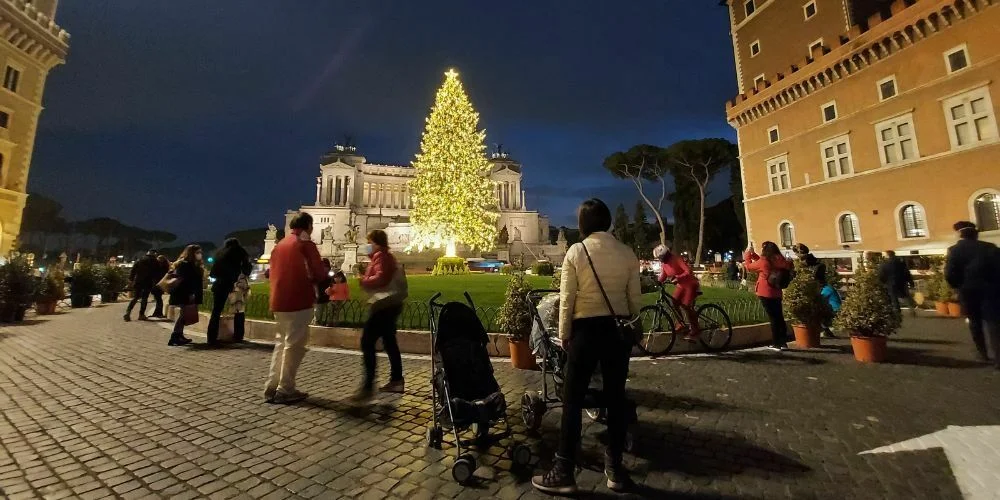Italy has many but not particularly long rivers. We will tell you everything, or almost everything, you might want to know about the most important rivers in Italy.
Over 1200 rivers are counted in Italy, among which the Po, the Arno and the Tiber are the best known. The cities of Turin, Florence and Rome are situated on these three rivers respectively.
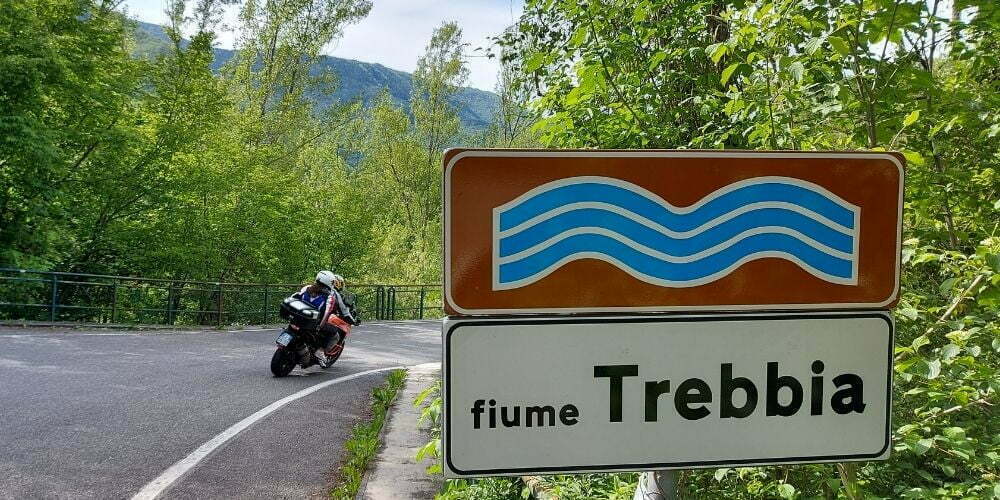
Even though Italy has many rivers, the waterways are relatively short. The longest Italian river is the Po and has a length of 652 kilometres. This is nothing compared to the Danube (2858 km), the Rhine (1320 km) or the Volga (3532 km), Europe’s longest river.
This content is not shown.
Click on this block to display all our content, by accepting our cookies or review our cooky-policy below.
Just as the rivers of Italy do not distance very long, they also have short names. In our list, the river names have six letters at the most. Possibly a coincidence.
Alps and Apennines
The rivers in Italy are somewhat on the short side and generally have a small flow area. This is due to the fact that Italy is a relatively narrow and long country. Almost the entire length of the country is covered by the Apennines, a mountainous region that divides the water into two opposite sides.
The rivers of Italy originate either in the Alps (glaciers) or in the Apennines, where large karstic springs are the source. The few rivers in Sardinia and Sicily obviously have a different origin. Rivers are important elements of nature in all times and cultures. In antique (Roman) times, some rivers were symbolised as reclining gods with symbols of abundance and fertility.
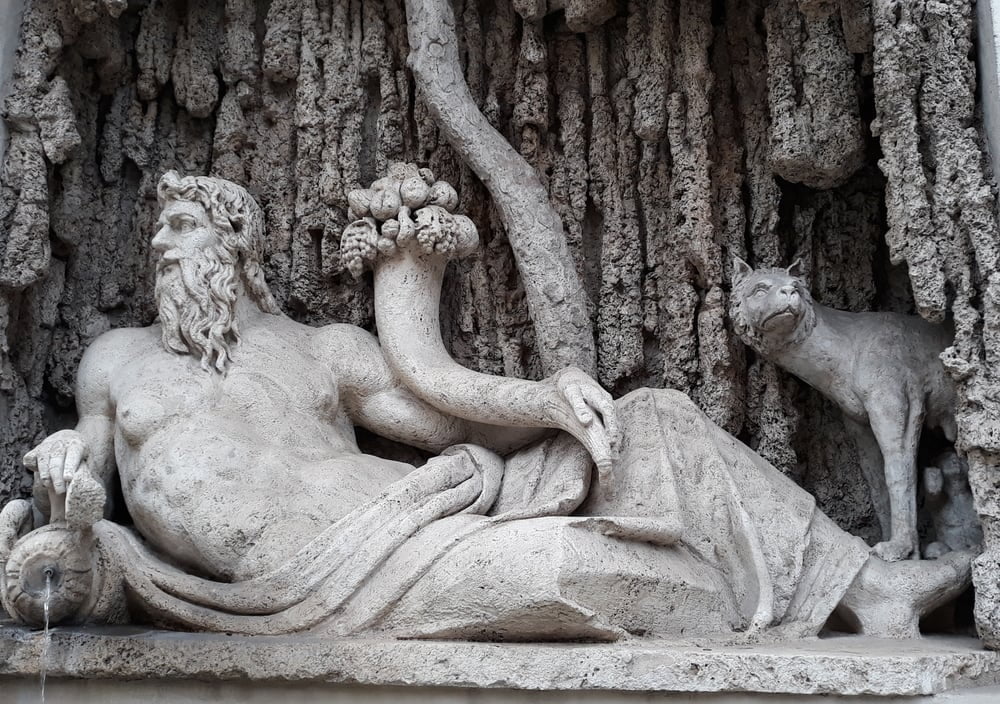
Longest Rivers in Italy
Rivers do not respect national borders and therefore top 10 rankings. With this idea in mind, we can say that the longest river in Italy actually is the Drava.
This content is not shown.
Click on this block to display all our content, by accepting our cookies or review our cooky-policy below.
This river has its source at San Candidio in South Tyrol and flows 749 kilometres further into the Danube, in Hungary. The Drava river runs only for about ten kilometres on Italian territory (after that, it plunges into Austria).
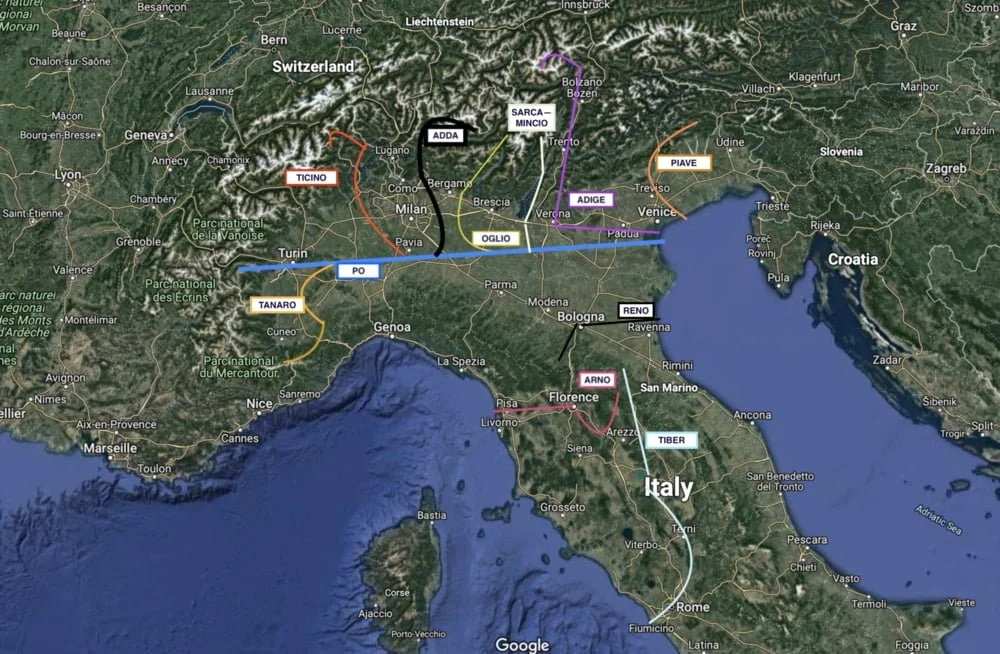
But if we consider ‘purely’ Italian rivers, and that is as customary, we come up with the following top 10 of Italy’s longest rivers. As a bonus, we add another river, which actually consists of two rivers. Read on, and you will understand 🙂
Po – A people river
- Length: 652 km (405 ml)
- Discharge: 1,540 m3/s
- Start: Cottian Alps (near the border with France)
- Finish: Adriatic Sea (near Adria)
- Important cities: Turin, Piacenza
Italy’s longest river is the Po. It runs from west to east and passes through Turin and Piacenza, among other places. Milan is connected to the Po by a system of canals, which originated in the mind of Leonardo da Vinci.
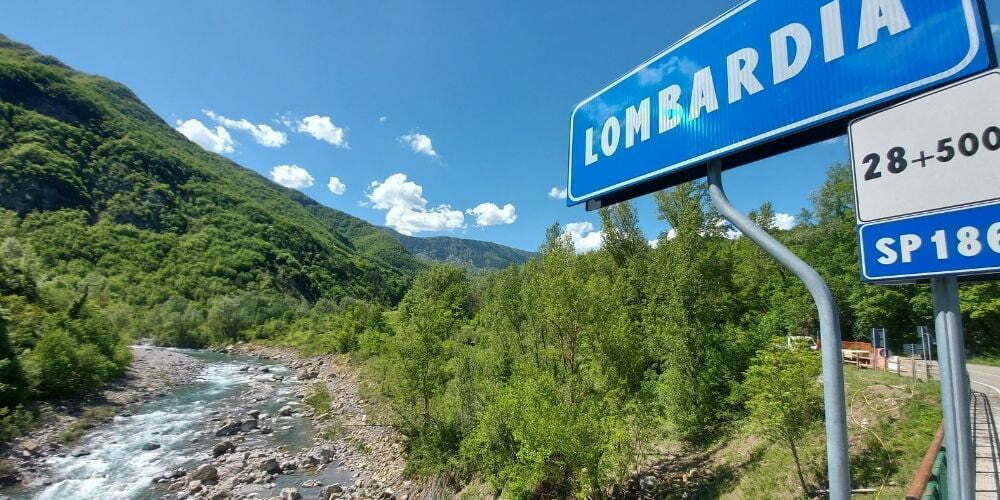
The vast plain around the Po is called the Po Valley. It is Italy’s most important industrial and agricultural area. It is not the sexiest part of the country: it is flat, almost a third of Italy’s population lives there and the fog often gives a grey and sad glow. The river is not the cleanest, due to the industrial and agricultural activities and the busy urbanisation in the area. In the Po, values indicating a high consumption of cocaine are sometimes measured during sampling.
This content is not shown.
Click on this block to display all our content, by accepting our cookies or review our cooky-policy below.
The Po has always had something hard, something unsatisfying, at least not very scenic. The later world-famous director Michelangelo Antonioni shot a short docu-film in 1943 about the difficult circumstances of ‘People of the Po’, see below:
However, the Po has nowadays some interesting areas for water tourism, especially in the Po Delta, at the end of its course. Two parks have been created, one near Ferrara and one near Ravenna. The parks are one of the most beautiful oases in Italy, and the second largest wetland in Europe. Various visitor centres and museums are present there. Ideal for lovers of hiking, horse riding, bird watching etc.
Adige – Bike grills valley
- Length: 410 km (255 ml)
- Discharge: 1,540 m3/s
- Start: Vinschgau Valley (South Tyrol)
- Finish: Adriatic Sea (south of Venice)
- Important cities: Bolzano, Trento, Verona
This river, which originates in the German-speaking part of Italy, is also known by its German name Etsch. The water passes through Bolzano, known among other things for the Ötzi Museum, about the famous Neolithic wet mummy, that is highly recommended.
This content is not shown.
Click on this block to display all our content, by accepting our cookies or review our cooky-policy below.
The Adige Valley cycle path is a cycle track that officially starts at the the source of the Adige River, and leads to its mouth in the Adriatic Sea. The Adige is thus the haven of cyclists, who are backed up by a network of support points along the way, for resting, eating and repairing bicycles. The points are called BiciGrill (with a nod to AutoGrill, restaurants along Italy’s motorways).
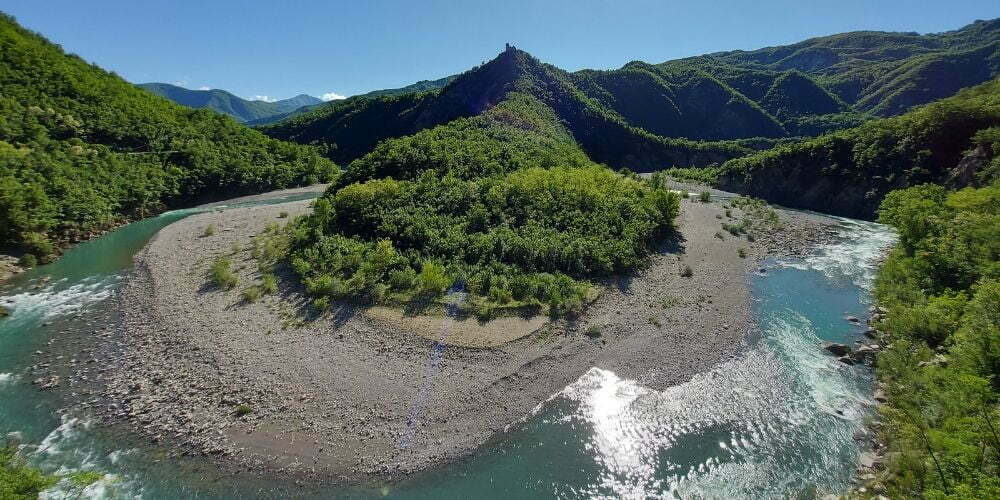
At the very beginning of the Adige is Lake Reschen, an artificial lake famous for the bell tower of the church of Graun im Vinschgau, which stands out above the water. The tower is the only relic of the village that disappeared when the lake was created in 1950. The Italian writer Marco Balzano has written a compelling story about this little town, the lake and the language conflict. If you are interested, read the review I wrote of the book.
In Graun of (in Italian) Curon is also Bunker No. 20 situated, part of the Alpine Wall made in the pre WW2 time. Along the border an extensive defence line was installed at that time to protect against a potential invasion by Germany.
Tiber – Rome’s mystic river
- Length: 405 km (252 ml)
- Discharge: 235 m³/s
- Start: Monte Fumaiolo (Apennines near Cesena)
- Finish: Mediterranean Sea (Ostia, part of Rome)
- Cities: Perugia, Rome
This content is not shown.
Click on this block to display all our content, by accepting our cookies or review our cooky-policy below.
The Tiber is possibly Italy’s most famous river, as it belongs to the history of Rome, the capital of the Roman Empire. The Tiber or Tevere in Italian, has been the soul of Rome since its birth. The fact that the city owes its very existence to it is described as early as the first scene of the founding legend, with Romulus and Remus in the basket who stranded at the foot of the Palatine Hill.
The ancient name of the river was Albula (from the adjective Albus = white), according to tradition referring to the clear color of its blond waters. Today, the river is still called blond (‘Biondo Tevere’). It is assumed that the current name derives from the Latin king Tiberinus Silvius, who drowned in this river.
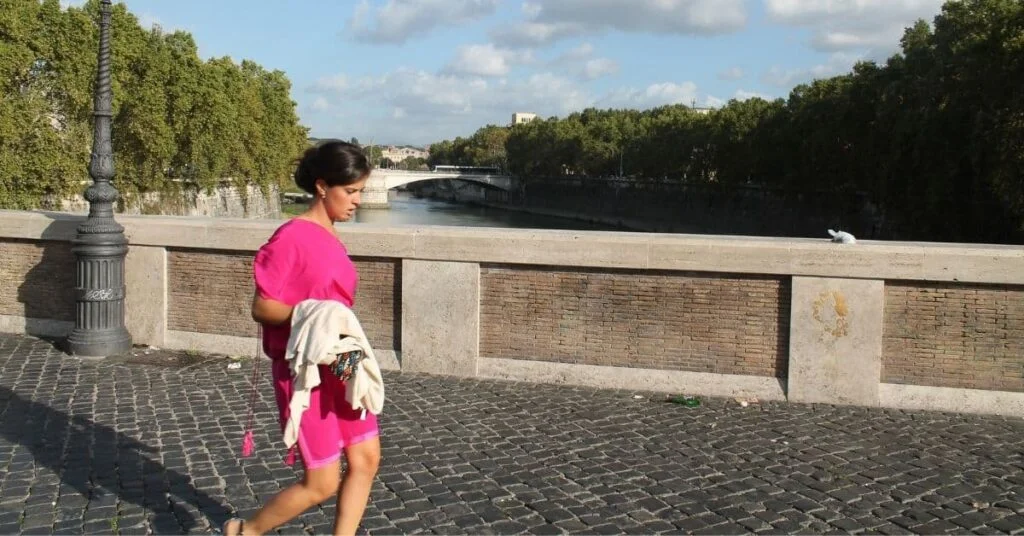
One hundred years ago Mussolini moved the regional borders of the Tiber, that originated in Tuscany, in order to fulfil his wish that the source of the Tiber should be in Romagna, his region of origin. He could thus ‘prove’ that his assumption of power and historical continuity was no accident. The ‘holy’ river started near his home and ended in the town of his government.
This content is not shown.
Click on this block to display all our content, by accepting our cookies or review our cooky-policy below.
Some 20 nature parks have been set up along the course of the Tiber, of which the Veio regional park is worth extra mentioning. This natural area is located near Rome and its territory is wedged between the Via Flaminia and the Via Cassia (both the roads built by the ancient Romans!). The area of 37,000 acres is dominated by the Etruscan city of Veio (ruins), hence the name of the park. The Veio park is a nice combination of scenic beauty with 99 kilometres of footpaths and cultural remains.
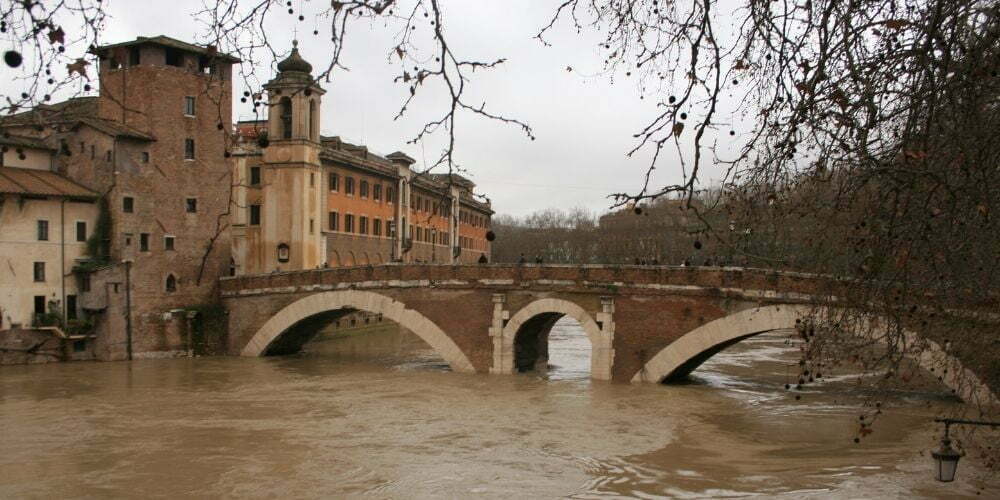
A nice, nostalgic film (set in 1990) in which the Tiber plays a major role is Notti Magiche (‘Magic nights’), a 2017 film by Paolo Virzi.
Adda – Leonardo da Vinci’s waterworks in practice
- Discharge: 187 m³/s
- Start: Alpisella (Lombardy)
- Finish: in the Po, near Cremona
- Cities: Lecco (Como Lake), Lodi
The Adda is a tributary of the Po, but not just a tributary. With its 313 kilometres, it is Italy’s fourth largest river, meandering through Lombardy.
This content is not shown.
Click on this block to display all our content, by accepting our cookies or review our cooky-policy below.
One of the most interesting stretches is the so-called ecomuseum of Leondardo Da Vinci, on the lower reaches of the river. The name honours Leonardo da Vinci, who stayed in the villa of his pupil Francesco Melzi in this area while working as a military engineer in the service of the Duke of Milan, He got the specific mandate of carrying out studies to improve the navigability of the river Adda and to strengthen the connections with the city of Milan by waterways.

The ecomuseum is completely open-air and runs for 21 km from north to south along the banks of the river Adda. It is divided into 18 stages which are called ‘rooms’ in analogy to those of a traditional museum.
One of the ‘rooms’ is the Leonardo’s ferry boat, a special type of hand-operated ferry, the only one still in working order that connects the towns of Imbersago and Villa d’Adda. The San Michele bridge, another ‘room’, is an impressive iron arch bridge with mixed rail-road traffic, built in 1899 and still in use today.
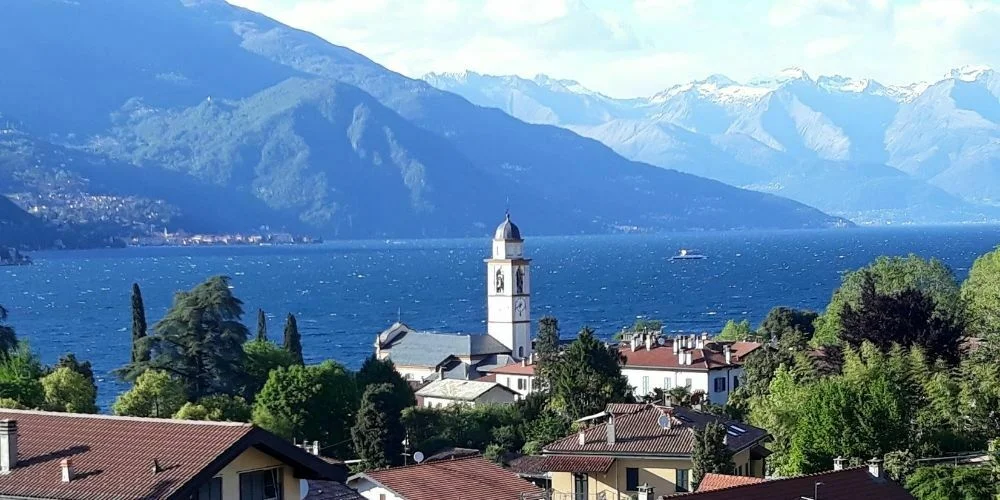
Related content: Leonardo fans should also visit Vinci (350 km south), where the inventor was born and where you can visit an interesting museum.
This content is not shown.
Click on this block to display all our content, by accepting our cookies or review our cooky-policy below.
Oglio – Fly fishing Valhalla
- Length: 280 km (194 ml)
- Discharge: 137 m³/s
- Start: Ponte di Legno (Lombardy)
- Finish: in the Po, between Mantua and Parma
The Oglio has its source not far from the Adda. Both rivers start in het national park of the Stelvio. Another similarity is that also the Oglio runs from north (Alps) to south and flows into the Po. The river does not pass through large cities and is therefore an advantage for nature lovers.
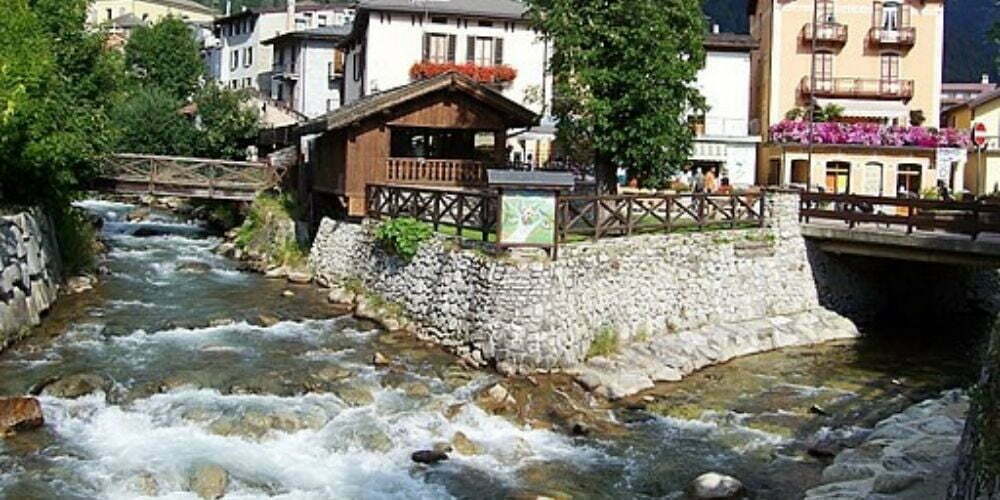
The river is sought after by many angler enthusiastiscs. In particular for fly fishing. In this discipline an artificial fly is used as lure to imitate the natural prey of fish, mainly insects, but also small fish, and even frogs. Fly fishing is used for salmonids (trout, grayling, char, salmon), but also also for pike, perch and carp.
Its’ no acident that in the small town of Vezza (1,500 inhabitants) the European Union of Fly Fishers was founded. This says enough about the importance of the Oglio River in the world of fishing.
This content is not shown.
Click on this block to display all our content, by accepting our cookies or review our cooky-policy below.
Tanaro – Truffle, wine and anti-aging cream
- Length: 276 km (171 ml)
- Discharge: 116 m³/s
- Start: Pian Laiardo (Piedmont)
- Finish: in the Po, in Liguria
- City: Alessandria, Asti
There is a (slight) debate as to whether the Tanaro is in fact the longest river in Italy. In fact, this river is longer than the Po (276 km versus 230 km) at its confluence with the Po. That should be the reason why the river up to the Adriatic should be called Tanaro and not Po. Do you still follow it? Well, in a nutshell, by coincidence we are talking about the Po Valley and not the Tanaro Valley as one of Europe’s most important industrial areas.
So why then is the Tanaro known?
The river passes through Asti and Alba, two places that are world-famous for their gastronomic peculiarities. Asti and its hills are known for their sweet wines: the main grape variety is Moscato Bianco, from which a (sparkling) spumante, a passito and a ‘quiet’ (=without bubbles) wine are obtained. The most known variety is the Asti spumante sparkling wine.
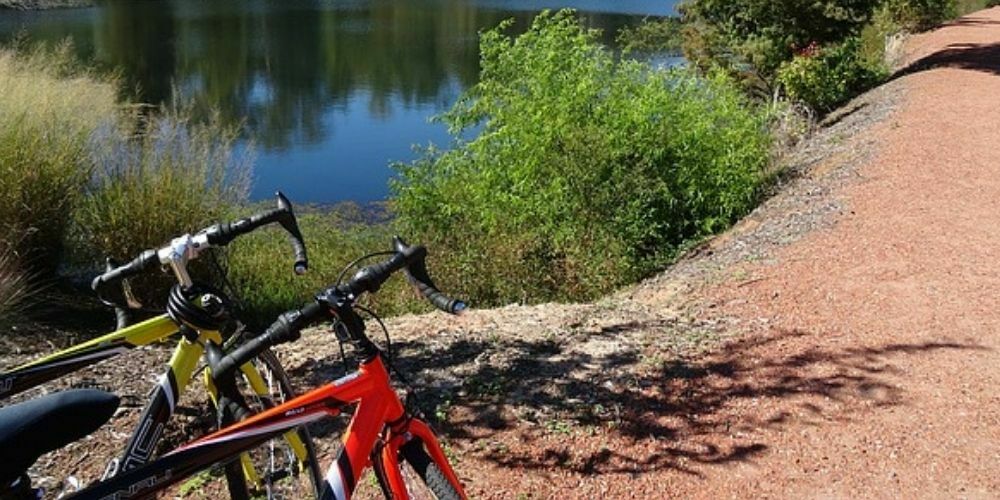
Alba is the centre of the white truffle. This truffle, also called ‘Tuber Magnatum Pico’ is considered to be the most prized truffle. The Alba (white) truffle cannot be cultivated and is hunted down underground by local farmers with specially trained dogs. Truffle hunting is strictly regulated by law and only possible at certain times of the year, under penalty of severe penalties. You can imagine what that means for the price level of this fungus, because that is what the truffle is.
This content is not shown.
Click on this block to display all our content, by accepting our cookies or review our cooky-policy below.
By an aside, white truffle extract from Alba is also popular nowadays as an anti-wrinkle cream, spray and gel.
Alba is part of the Langhe region, also famous for its wines, which include grape varieties Nebbiolo and Barolo.
Ticino – Gold digging near Milan
- Length: 248 km (154 ml)
- Discharge: 348 m³/s
- Start: Switzerland
- Finish: Po, near Pavia
- City: Pavia
The Ticino is a river that has its origin in Switzerland, and so its length is debatable as to whether it belongs to the top 10 longest rivers in Italy. As for his Italianness, you could argue that where the river originates, in the canton of Ticino, the language spoken is Italian. That is something. By the way, the river is (rightly) ranked high (second) in terms of water discharge.
Like all rivers that run at the foot of mountain ranges, the Ticino is a basin in which gold can be found. The gold content is not high enough to make it profitable. The gold is present in the form of straws generally no longer than a millimetre, and the gold potential of the Ticino is calculated to be 6-8 grams per ton of sifted sand.

The Romans did mine gold out of the Ticino however and were ‘fortunate’ not to have to bear labour costs by employing thousands of slaves. The search for alluvial gold is nowadays only an amateur naturalistic activity, especially in the province of Pavia.
This content is not shown.
Click on this block to display all our content, by accepting our cookies or review our cooky-policy below.
The Ticino Park, that stretches from Lake Maggiore to the provinces of Varese, Milan and Pavia, offers a hiking network of approximately 780 km. Excursion by Canadian canoe is a fun activity to be done near Vigevano.
Arno – Renaissance River
- Length: 241 km (150 ml)
- Discharge: 110 m³/s
- Start: Tuscan Apennines
- Finish: Mediterranean Sea (Marina di Pisa)
- Cities: Florence, Pisa
The Arno may be only the eighth largest river in length, it is one of the most famous in Italy. This is due, among other things, to Florence, where the manger of the Renaissance stood. How many artists, inventors and (wo)men of letters have ‘sung’ about the Tiber? Think of people like Dante, Botticelli and Macchiavelli.
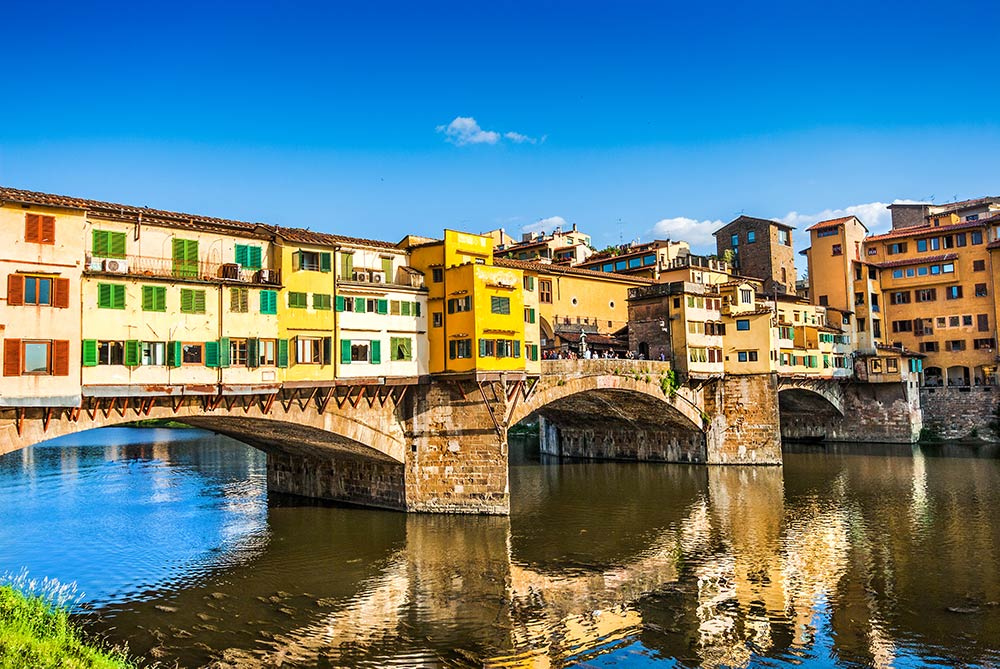
The river has its source in the same area as the Tiber, that other river that has written so much history. But where the Tiber runs rather directly to the south, the Arno makes a sudden turn and goes straight to the west. There, in Pisa, is that other important city of the Middle Ages and Renaissance situated, the city of Galileo Galilei and others.
The Arno now offers wonderful excursion possibilities, such as near Rignano sull’Arno (close to Fiesole, Florence).
This content is not shown.
Click on this block to display all our content, by accepting our cookies or review our cooky-policy below.
Piave – A history of battlefields
- Length: 231 km (150 ml)
- Discharge: 137 m³/s
- Start: Alps (Monte Peralba, province of Belluno)
- Finish: Adriatic Sea (Jesolo, near Venice)
Piave is known by Italians not so much for its geography as for its history. In the First World War the river and the mountain range Monte Grappa three battles took place that shaped modern Italy. In 1917 and 1918 the Austrians, who wanted to curb the Italians’ struggle for land extension, were defeated here.
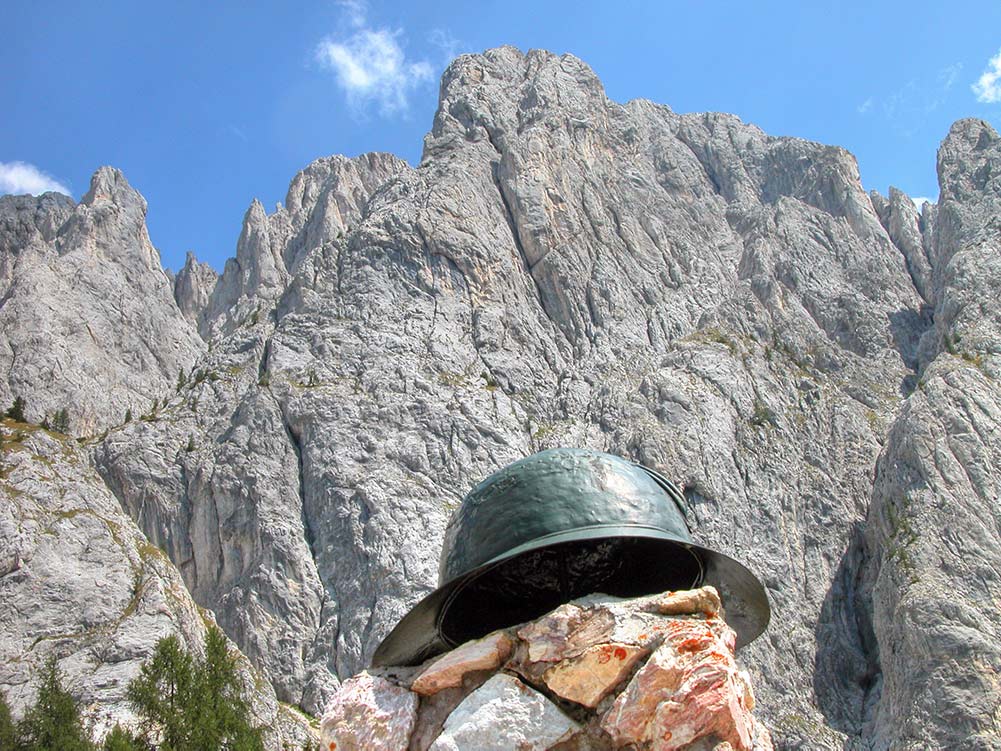
The Piave river and the area around it is a good place for people with an interest in (long) past war sites. A path has been marked out along some 30 kilometer of the Austro-Hungarian front of the First World War. The whole route can also be covered by car, making stops along the way.
For those interested, a book was published in late 2021 with routes along the battlefields and numerous photos, also useful for an English-speaking audience.
Reno – Running waters and trains
- Length: 212 km (132 ml)
- Discharge: 95 m³/s
- Start: Tuscan Apennines (province of Pistoia)
- Finish: Adriatic Sea (near Ravenna)
- City: Bologna
This content is not shown.
Click on this block to display all our content, by accepting our cookies or review our cooky-policy below.
The Reno is not the same as the Rhine in Northern Europe, although both river names are derived from the same hydronym, meaning ‘water that runs’. This name could be applied to any river (perhaps that is why there are at least two of them already…).

The water is used extensively for energy generation during its course. The city of Bologna (almost 400,000 inhabitants) depends on this river for its water, among other things.
You can divide the river into two parts with the hinge being a medieval lock in the municipality of Casalecchio di Reno in Emilia Romagna. That represents the point where the Reno abandons its natural mountain path to enter the plain valley through the Reno Canal.
More exciting is therefore the part on the western side of Casalcchio, because there the nature is more pristine. Also of particular interest is a part of the Bologna-Porretta-Pistoia railway line that runs along a part of the river course with works of art (bridges, tunnels, retaining walls) that represent a true masterpiece of engineering from the time of construction (1864).
This content is not shown.
Click on this block to display all our content, by accepting our cookies or review our cooky-policy below.
Sarca-Mincio – A maze of rivers
- Length: 203 km (126 ml)
- Discharge: 39 m³/s (Sarca) and 60 m³/s (Mincio)
- Start: Pinzolo (Trentino)
- Finish: Lake Garda and Rivier Po
The length of these two rather unknown rivers is a bit artificially inflated, if you ask me. One river, the Sarca, discharges on the north side of Lake Garda. Another river, the Mincio, originates on the south side of the same lake. In my opinion, these are two different rivers, but specialists in ‘river science’ consider them to be one and the same course. This makes the Sarca-Mincio the eleventh longest river of Italy.
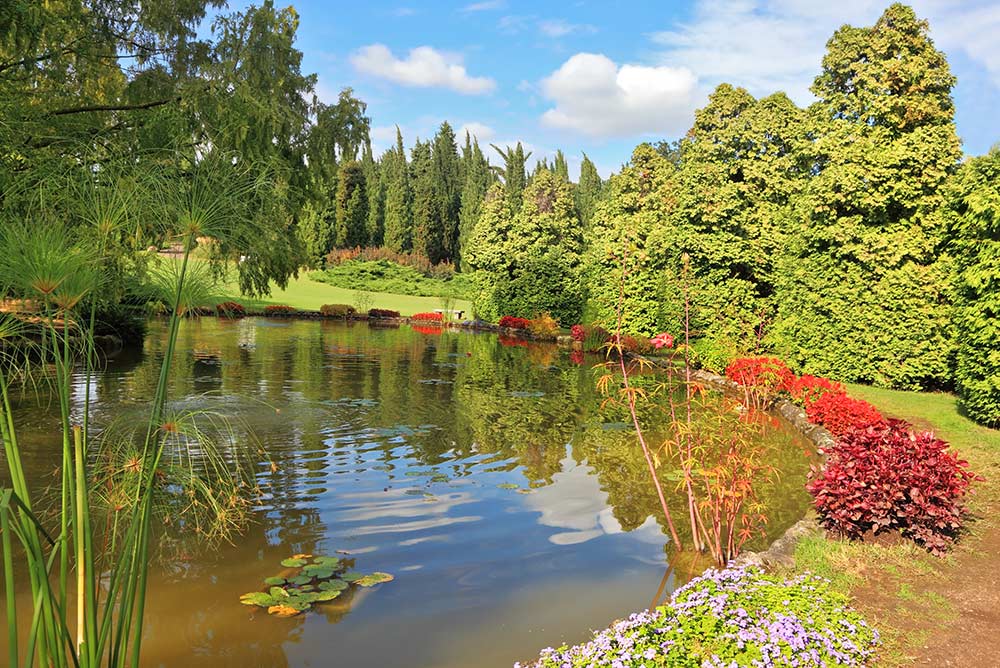
An absolute must is to visit Parco Giardino Sigurtà, which is situated next to the Mincio, near Peschiera. The park (with entrance fee) is a combination of flowers, plants and classic park construction. Eye-catching features include the Labyrinth, an extraordinary maze of hedges made up of 1,500 yew trees, the Votive Grotto that is protected by oaks and thick woods and the Avenue of the Roses, with a million tulips that embellish the lawns as from March.
Q&A on rivers in Italy
What is Italy’s longest river?
The Po is the longest river in Italy. It originates in the Alps near France and flows after 652 km (405 ml) into the Adriatic Sea. Turin is situated on the Po and Milan is not.
What river runs through Florence?

The Arno is the river that flows through the heart of Florence, and also runs through the centre of Pisa. It is Italy’s eighth-largest river.
How many rivers are in Italy?
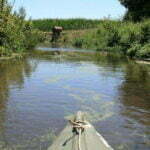
Italy has more than 1200 rivers. The longest is the Po (652 km), the shortest is the Aril (175 meter) near Verona.
What are the 5 main rivers in Italy?
The longest rivers and their most important cities are: the Po (Turin), Adige (Verona), Tiber (Rome), Adda (Lodi) and Oglio (none).
This content is not shown.
Click on this block to display all our content, by accepting our cookies or review our cooky-policy below.

